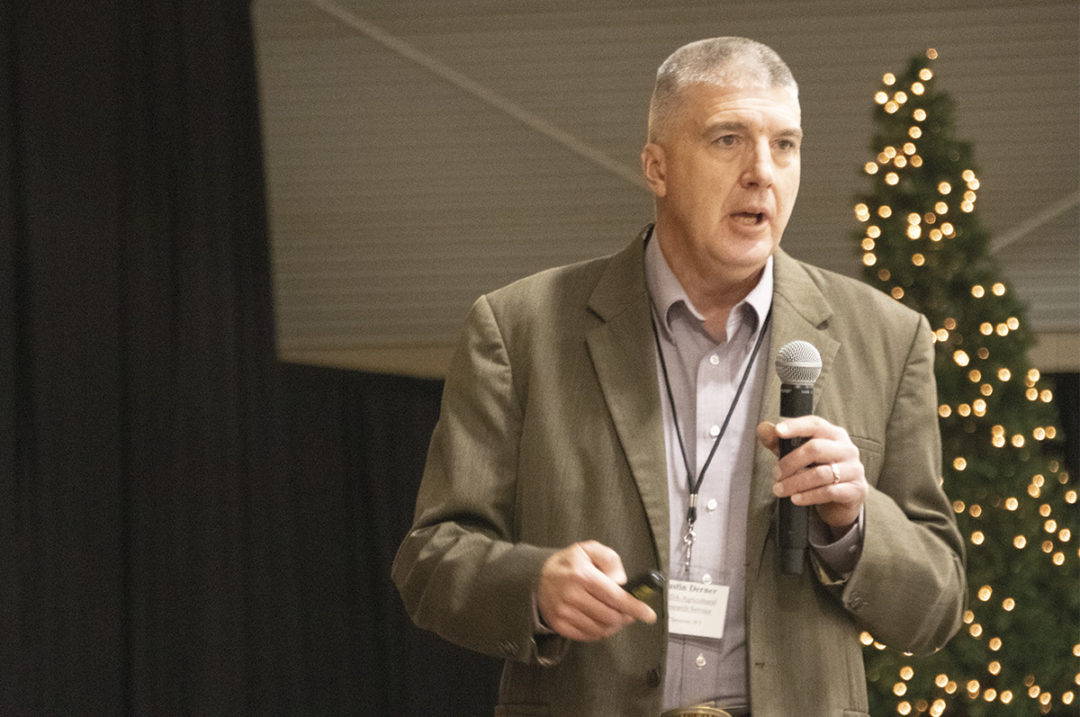The biennial Range Beef Cow Symposium was hosted Dec. 13-14 by Colorado State University in Loveland, Colorado. Some 400 attendees from across North America gathered to hear the latest in beef cattle research from some of the industry’s leading experts from government, academia and industry. With an eye toward ranch profitability and overall industry health, topics ranged from nutrition to reproduction, from sustainability to public lands grazing, even to Colorado’s recent reintroduction of gray wolves to the state.
As is often the case with these industry events, attendance was much like drinking from a firehose. While we can’t adequately share all the details we’d like to, let’s hit some of the highlights.
Enhancing carrying capacity
“Who likes free forage?”
This was the question posed by Justin Derner, a rangeland scientist with the USDA’s Agricultural Research Service (ARS) based in Cheyenne, Wyoming, during his presentation. The answer, of course, is everyone.
The question is: Where does this “free forage” come from? And what’s in the way of producers accessing it? Wild plant species unsuitable for grazing, such as cheatgrass, prickly pear and western red cedar, continue to spread in much of the West and Plains, restricting access to grazing. Developers continue swallowing up land. Even modern farming practices have made livestock grazing a trickier proposition in some areas than in years past.
With all these challenges, how can producers make their grazing lands more productive and profitable? Derner offered a few key areas to focus on.
- Understanding plant physiology: “How many people thought their plant physiology class in college would be useful on their ranching operations?” said Derner. “It is huge.”
Carbon dioxide can and should be manipulated to cattle producers’ advantage. Despite all the challenges listed above, the U.S. has seen a 60% increase in forage production from the 1950s to now, largely thanks to an increased focus on keeping organic matter in the soil. However, while added soil carbon means a higher quantity of forage, without the benefit of added nitrogen, most of that forage is of lower quality. Understanding how the plants on your grazing range interact with one another, the soil and different grazing practices will improve your cattle’s grazing experience.

“Fertility is not a one-time event,” said Shelby Rosasco of the University of Wyoming. “Everything we’re doing throughout the year is impacting fertility.” Photo by Tyrell Marchant.
- Improving soil water retention: Over the decades, land managers have spent countless millions of dollars on big infrastructure projects to hold on to water, to decidedly mixed results. Just as much, if not more, good can be done by focusing on the soil’s ability to retain that precious water. Derner suggested producers keep a good plant cover over the soil, make sure there are living roots as long as possible, increase plant biodiversity (which, in turn, increases microbial biodiversity in the soil) and minimize mechanical disturbance.
- Grazing multiple species: For a lot of reasons, many cattlemen are loath to be known as the guy who also has sheep and/or goats on the place. But Derner told producers that, if they could manage through the labor and infrastructure barriers involved, adding species to the grazing rotation optimizes what the land can offer.
- Management acumen: Derner encouraged producers to adopt practices that allow them to “chase the green,” such as virtual fences, targeted grazing, development of riparian areas and getting a firmer grasp on wildlife migration corridors through their range.
Derner said he is confident that almost every ranch still in operation is producing more with its resources than ever before, and doing so while improving the land and environment around them. He stressed the importance of keeping good records, which will help individual producers understand what best practices are for their respective environments, as well as to demonstrate their good stewardship to the public and their customers.
“All of you should be proud of the fact that the productivity of your places has increased tremendously,” he said. “I hope you have the data to prove it.”
Vaccines’ effects on reproductive performance
“Why do we vaccinate the cow herd? It’s for the calf,” said George Perry, a research professor of beef cattle reproductive physiology with Texas A&M AgriLife.
Perry’s presentation focused on treatment of two diseases, bovine viral diarrhea (BVD) and infectious bovine rhinotracheitis (IBR), and how different vaccination options for those illnesses affect reproduction. When cows are infected with BVD or IBR, it can result in lower conception rates for both A.I. and natural service, early embryonic death, congenitally infected calves and birth defects. All of this makes formulating and executing the proper vaccination program imperative.
Perry told symposium attendees that, depending on timing, both killed and modified-live vaccines can affect estrus cycles, particularly in cows that have never been treated before. He noted that conception rates have improved in studies when cows are vaccinated more than 45 days pre-breeding. Perry advised producers to consult with a trusted veterinarian on how, when and with what to vaccinate their mother cows because those decisions can have generational impacts on the herd.
“When you get any vaccination, you know it affects you,” he said. “It’s the same thing with cattle.
“If vaccinations are affecting conception rates by 5 percent to 8 percent, we need to look at vaccinating differently.”

Texas A&M’s George Perry touted the long-term profitability of collaborating with a veterinarian to determine what vaccination program will be best for cows’ reproductive health. Photo by Tyrell Marchant.
A systems approach to reproductive efficiency
Range cows are expected to be metabolically and reproductively efficient in varied and changing environments. Shelby Rosasco, extension beef specialist with the University of Wyoming, urged producers to know exactly what reproductive efficiency means on their outfit.
“Efficiency in one environment does not equate to efficiency in another environment,” she said.
To do this, Rosasco said, they need to optimize pregnancy rate early in the breeding season and select and develop replacement heifers that are highly fertile and remain in the herd a long time, all at the lowest possible cost.
“Fertility is not a one-time event,” she said. “Everything we’re doing throughout the year is impacting fertility. … We need to be looking at the overall system.”
Management decisions across the production spectrum affect reproduction, from weather to feed availability to money. Studies have shown a strong relationship between nutrition and reproduction, with good nutrition early in a heifer’s life leading to earlier puberty, earlier and more consistent estrus, and longevity in the herd. An early-calving cow will produce about the equivalent of one more calf over her lifetime than her later-calving herdmates, so there is a definite impact on the bottom line in encouraging better reproductive efficiency.
A generally accepted guideline in the industry is that heifers need to reach 60% to 65% of mature bodyweight before their first breeding. Rosasco said this is a good benchmark, but posed the questions, “Can we target a lighter mature bodyweight in certain production environments? What cow is actually efficient on your grazing range?”
With those considerations in mind, Rosasco said producers will be better able to use their post-weaning management to select heifers better adapted to the production environment in which they will be expected to perform throughout their lives.







